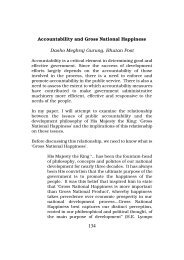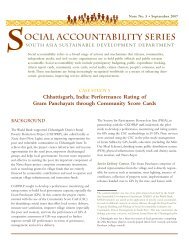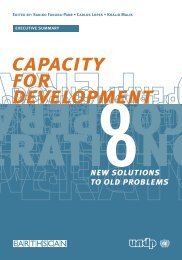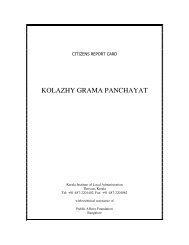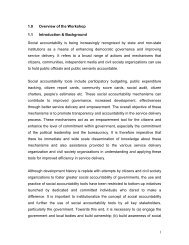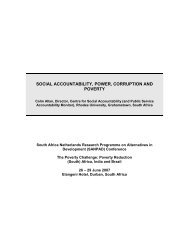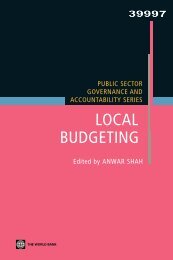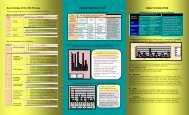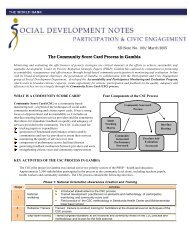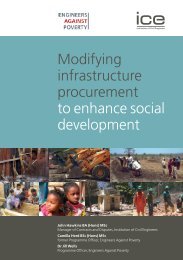Enabling Environment for Social Accountability in ... - SASANet
Enabling Environment for Social Accountability in ... - SASANet
Enabling Environment for Social Accountability in ... - SASANet
Create successful ePaper yourself
Turn your PDF publications into a flip-book with our unique Google optimized e-Paper software.
How frequently has your organization been <strong>in</strong>volved <strong>in</strong> the follow<strong>in</strong>g activities?<br />
At least monthly:<br />
Comment publicly on official conduct or policy 23%<br />
Undertake advocacy <strong>for</strong> a change <strong>in</strong> public policy or legislation 26%<br />
Meet or correspond directly with public officials (<strong>in</strong><strong>for</strong>mally) 56%<br />
Participate <strong>in</strong> a public hear<strong>in</strong>g/meet<strong>in</strong>g 61%<br />
Participate <strong>in</strong> state commission or advisory committee 21%<br />
Monitor government expenditure 7%<br />
Monitor the per<strong>for</strong>mance of public services 22%<br />
Analyze budgets or expla<strong>in</strong> them to citizens 8%<br />
Other 11%<br />
In your op<strong>in</strong>ion, which of the activities described <strong>in</strong> the previous question are likely to result <strong>in</strong><br />
changes <strong>in</strong> public policy, legislation, or conduct of public officials?<br />
Often to Almost Always:<br />
Comment publicly on official conduct or policy 53%<br />
Undertake advocacy <strong>for</strong> a change <strong>in</strong> public policy or legislation 60%<br />
Meet or correspond directly with public officials (<strong>in</strong><strong>for</strong>mally) 66%<br />
Participate <strong>in</strong> a public hear<strong>in</strong>g/meet<strong>in</strong>g 40%<br />
Participate <strong>in</strong> state commission or advisory committee 35%<br />
Monitor government expenditure 42%<br />
Monitor the per<strong>for</strong>mance of public services 58%<br />
Analyze budgets or expla<strong>in</strong> them to citizens 50%<br />
Other 0%<br />
J. In relation to the activities listed above, how frequently have you received the follow<strong>in</strong>g types of<br />
responses from public officials?<br />
At least sometimes:<br />
Your recommendations were <strong>in</strong>corporated and policy or conduct changed 44%<br />
Public official(s) were held accountable <strong>for</strong> wrongdo<strong>in</strong>g 4%<br />
Received direct feedback (<strong>for</strong> example, <strong>in</strong> the <strong>for</strong>m of a letter or telephone call) 41%<br />
Received negative feedback (<strong>for</strong> example, <strong>in</strong> the <strong>for</strong>m of criticism or sanction) 35%<br />
Received no feedback or response 34%<br />
Other 1%<br />
Rate the follow<strong>in</strong>g types of public officials accord<strong>in</strong>g to the degree to which they are receptive to the<br />
activities listed <strong>in</strong> Questions H and I.<br />
At least usually receptive:<br />
National officials 45%<br />
Local officials 48%<br />
Senior officials 37%<br />
Middle- and low-rank<strong>in</strong>g officials 40%<br />
Are public officials work<strong>in</strong>g <strong>in</strong> certa<strong>in</strong> m<strong>in</strong>istries or policy areas more or less receptive to the<br />
activities listed <strong>in</strong> Questions H and I?<br />
Some are more receptive 8%<br />
Some are less receptive 26%<br />
No difference between m<strong>in</strong>istries or policy areas 18%<br />
103




